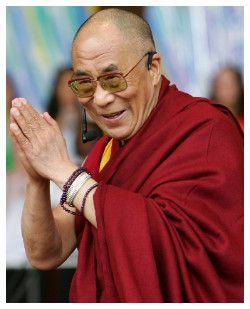Post by sparklekaz on May 4, 2012 1:49:11 GMT

His Holiness the 14th Dalai Lama, Tenzin Gyatso, is both the head of state and the spiritual leader of Tibet. He was born on 6 July 1935, to a farming family, in a small hamlet located in Taktser, Amdo, northeastern Tibet. At the age of two the child, who was named Lhamo Dhondup at that time was recognized as the reincarnation of the 13th Dalai Lama, Thubten Gyatso. The Dalai Lamas are believed to be manifestations of Avalokiteshvara or Chenrezig, the Bodhisattva of Compassion and patron saint of Tibet. Bodhisattvas are enlightened beings who have postponed their own nirvana and chosen to take rebirth in order to serve humanity.
His Holiness began his monastic education at the age of six. The curriculum consisted of five major and five minor subjects. The major subjects were logic, Tibetan art and culture, Sanskrit, medicine, and Buddhist philosophy which was further divided into a further five categories: Prajnaparimita, the perfection of wisdom; Madhyamika, the philosophy of the middle Way; Vinaya, the canon of monastic discipline; Abidharma, metaphysics; and Pramana, logic and epistemology. The five minor subjects were poetry, music and drama, astrology, motre and phrasing, and synonyms. At 23 he sat for his final examination in the Jokhang Temple, Lhasa, during the annual Monlam (prayer) Festival in 1959. He passed with honours and was awarded the Geshe Lharampa degree, the highest-level degree equivalent to a doctorate of Buddhist philosophy. Leadership Responsibilities
In 1950 His Holiness was called upon to assume full political power after China's invasion of Tibet in 1949. In 1954, he went to Beijing for peace talks with Mao Zedong and other Chinese leaders, including Deng Xiaoping and Chou Enlai. But finally, in 1959, with the brutal suppression of the Tibetan national uprising in Lhasa by Chinese troops, His Holiness was forced to escape into exile. Since then he has been living in Dharamsala, northern India, the seat of the Tibetan political administration in exile.
His Holiness began his monastic education at the age of six. The curriculum consisted of five major and five minor subjects. The major subjects were logic, Tibetan art and culture, Sanskrit, medicine, and Buddhist philosophy which was further divided into a further five categories: Prajnaparimita, the perfection of wisdom; Madhyamika, the philosophy of the middle Way; Vinaya, the canon of monastic discipline; Abidharma, metaphysics; and Pramana, logic and epistemology. The five minor subjects were poetry, music and drama, astrology, motre and phrasing, and synonyms. At 23 he sat for his final examination in the Jokhang Temple, Lhasa, during the annual Monlam (prayer) Festival in 1959. He passed with honours and was awarded the Geshe Lharampa degree, the highest-level degree equivalent to a doctorate of Buddhist philosophy. Leadership Responsibilities
In 1950 His Holiness was called upon to assume full political power after China's invasion of Tibet in 1949. In 1954, he went to Beijing for peace talks with Mao Zedong and other Chinese leaders, including Deng Xiaoping and Chou Enlai. But finally, in 1959, with the brutal suppression of the Tibetan national uprising in Lhasa by Chinese troops, His Holiness was forced to escape into exile. Since then he has been living in Dharamsala, northern India, the seat of the Tibetan political administration in exile.
Recomended Reading for those wanting to know more about this wonderful man: My Spiritual Journey by H.H. the Dalai Lama with Sofia Stril-rever. My Spiritual Journey provides a vivid and moving portrait of the Dalai Lama’s life journey that is personal in tone but universal in scope. He explores three phases or commitments of his spiritual life — as a human being, as a Buddhist monk, and as the Dalai Lama — each of which has made him more dedicated to exploring and teaching human values and inner happiness, promoting harmony among all religions, and advocating for the civil rights and well-being of the Tibetan people.




